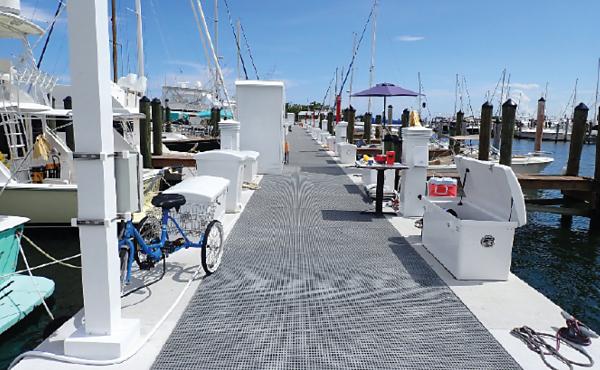Repairs bring new energy to Dinner Key Marina
by Cat Olnick
October marks one year since the reopening of Dinner Key Marina and its restoration to original operating capacity since suffering disastrous hurricane damage in 2017. Located in the Coconut Grove neighbourhood of Miami, Florida, Dinner Key Marina is the largest wet slip facility on the eastern United States, and Florida’s largest marina with 587-slips.

Dinner Key Marina, with 587 slips, is the largest marina on the eastern US seaboard.

Building new marina piers following the devastation caused by Hurricane Irma in 2017.

Old finger piers were underwater during 2021 ‘king tides’.

New piers experienced no flooding.
Construction phasing
The ability to keep the marina operational was a crucial element of the timeline. Cummins Cederberg worked closely with the Kearns Construction team to sequence the approach and minimise operating disruptions to the marina.
“The project phasing was really a fluid challenge for the project team to work through and coordinate during the entire construction operation,” says Kearns Construction team lead, Brock Sullivan. “Not only did our D-B team have to physically divide the work areas and staging locations, but we worked with the existing upland utilities to ensure service was uninterrupted for active slip users and dockmaster staff.”

Hurricane damage in 2017 affected 60% of the dockage.
The core of the structural work consisted of replacing the concrete access piers with a more slender profile consisting of two pre-cast beams laid parallel. This improved section provides more robust resistance to future wave impacts and allows easier access to utilities if future repairs are needed. Cost-efficient concrete repairs were performed to other existing walkway spans, pile caps and select piles in lieu of replacement.
As part of the D-B team’s efforts during pre-construction and active construction operations, opportunities were identified to optimise the construction scope and project budget. Cummins Cederberg and Kearns Construction performed multiple walkthroughs with the City to identify components that could be salvaged by means of repair, allowing funds to be reallocated to other improvements, such as replacing mooring piles or dock piles.
Storm damage repair and mitigation
The D-B team, in collaboration with the City, made the strategic decision to raise all the finger piers during the reconstruction to not only reduce future storm surge impacts but resist increasing seasonal water levels. Subsequently, at the end of construction, the 2021 ‘king tides’ provided record high water levels. The recently renovated piers experienced no flooding, while the existing docks in place during renovation were under water.

New fibre-mesh grated decking is non-slippery, safe under load, and allows sunlight to filter through to preserve marine life.
“There’s another layer when seeing the project in real time versus on paper,” states Cummins Cederberg senior project manager, Rasheed Muslimani. “By performing continual inspections, we found more opportunities to optimise the budget for the City and in this situation some dock piles didn’t need to be replaced, making it possible for all docks to receive new framing and decking.”
The D-B team’s optimised dock improvement scope provided new framing and decking for all timber docks – creating a consistent look, stability and access.
Upgraded utilities
Given most of the utility fixtures or supply feeds sustained damage from the storm, the scope included full overwater replacement of all utility systems including domestic water, fire protection, wastewater, electrical and low voltage. With MEP (Mechanical, Electrical and Plumbing) design led by Basulto & Associates and fire suppression design led by REDI Engineering, the team overcame many constructability challenges to address re-using existing upland utility feeds, adapting the design to meet current code requirements and maintaining service in phases.

Wi-Fi and security
New utility components were installed to provide a state-of-the-art user experience for both the marina staff and slip users. New security cameras were installed throughout the piers, along with Wi-Fi towers, and remote pedestal monitoring to track water and power consumption.
Safety and access
One of the functionality improvements incorporated by the D-B team was to replace the pier walkway surface with a fibre-mesh grating with a mid-span support beam instead of the previous pultruded glass fibre grating. This robust system provides greater stiffness under foot and support for golf carts and other operational equipment, as well as increased sunlight transmission through the pier to promote the health of underlying marine resources.
On Wednesday 20th October 2021, the City of Miami celebrated the completion of this comprehensive repair and upgrade project to the Dinner Key Marina, and it remains fully operational one year later. Funding for the marina repairs came through the Florida Inland Navigation District (FIND), the Federal Emergency Management Agency (FEMA), and revenues generated by the marina and other City funds.
Today, Cummins Cederberg continues work with the City of Miami to protect this $22.5-million investment by enhancing the protective spoil islands surrounding the marina. These enhancements will include a mix of hard and soft protection measures, such as rock breakwaters and nature-based enhancements as well as increased recreational opportunities to support the community friendly atmosphere prevalent in the region of Dinner Key Marina.
Cat Olnick is marketing manager for Cummins Cederberg, a professional engineering firm working exclusively in the coastal and marine environment. Its team of coastal and marine engineers, scientists, and regulatory experts, specialise in marina design, coastal dynamics, biological monitoring and environmental permitting.
www.cumminscederberg.com



